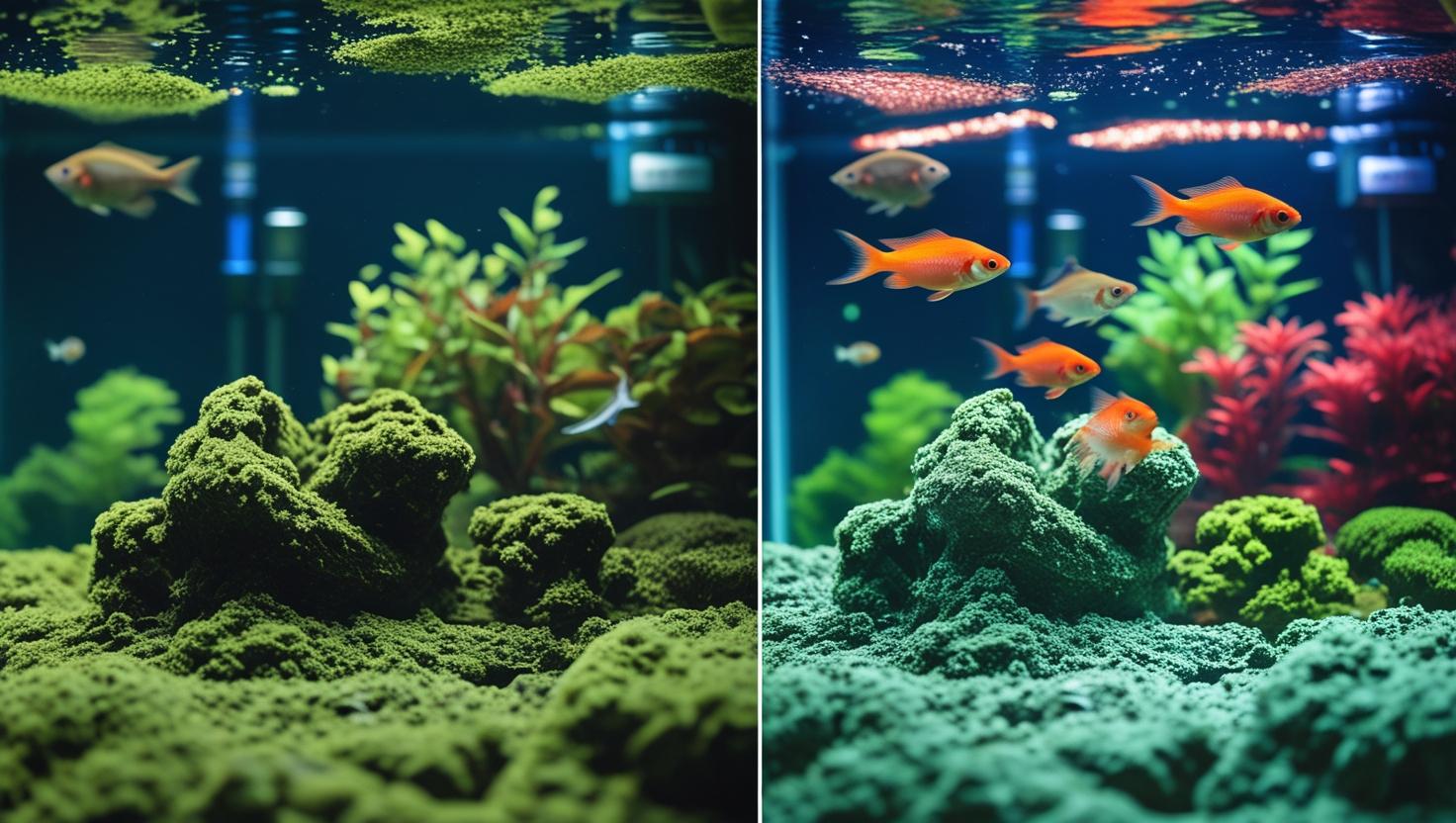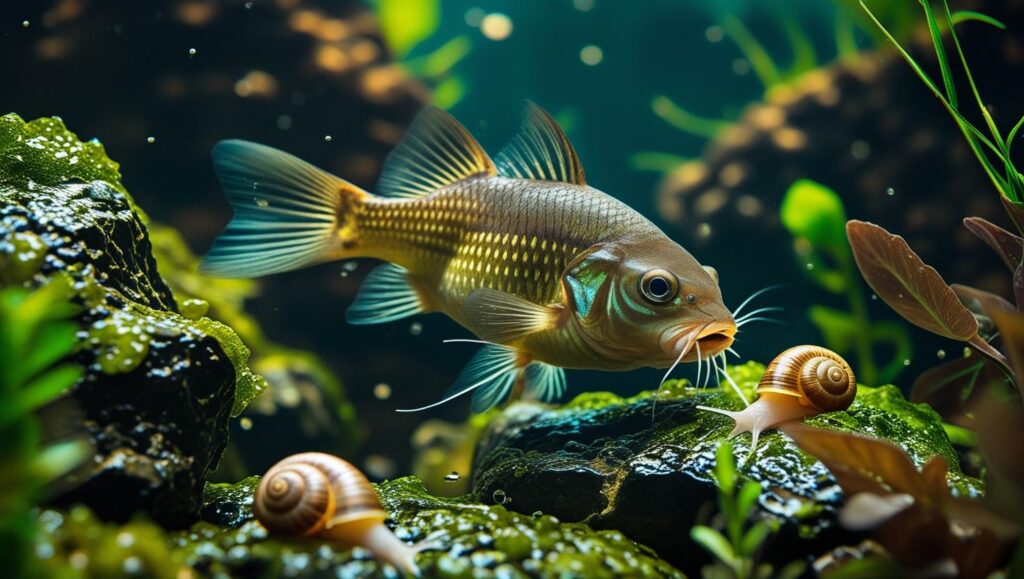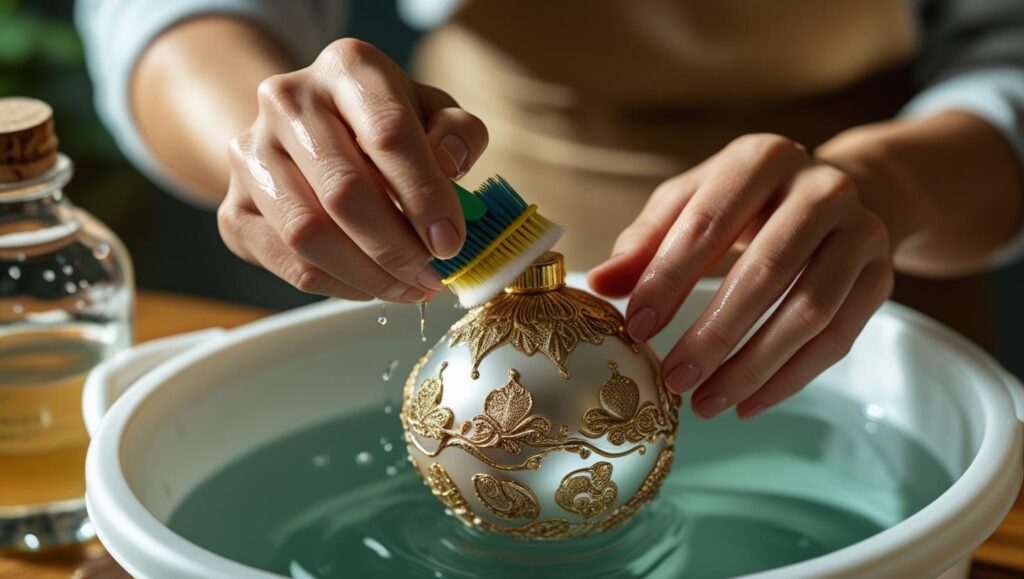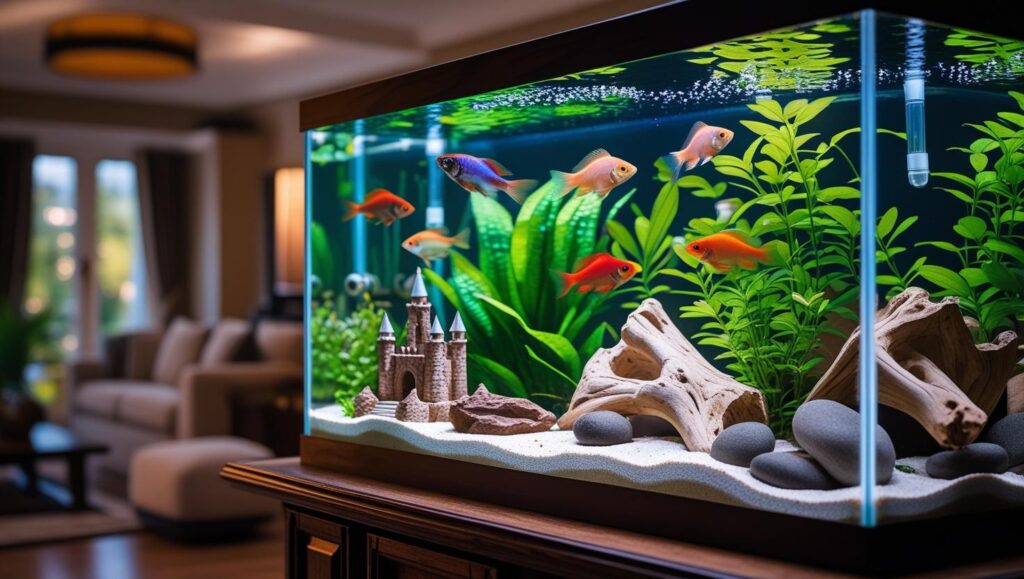How to Remove Algae from Aquarium Decorations Without Damage Easy 7 Steps

Ever glanced at your aquarium one morning and thought, “When did my beautiful tank turn into a green jungle?” If so, trust me, you’re in good company. Algae has a sneaky way of creeping in, clinging to your favourite decorations, and turning your crystal-clear haven into something that looks like it’s been abandoned for years. I still remember my first battle with it, my proud little shipwreck ornament looked more like a mossy relic pulled from the depths of the ocean. I tried scrubbing it with my hands, only to watch the green fuzz return like an unwelcome houseguest. If you’ve been frustrated by the same problem, this post is for you.
By the end, you’ll know exactly how to remove algae from aquarium decorations safely, without harming your fish or wrecking your setup, so your tank can get back to being the vibrant underwater world you love.

Why Does Algae Grow on Aquarium Decorations?
Algae grows on aquarium decorations because it loves light and nutrients. Give it too much of either, and it will spread fast. In nature, algae plays an important role. In your aquarium, it can be both a sign of life and a sign of imbalance.
Light: Too Much of a Good Thing
Algae needs light to grow. If your aquarium light stays on for more than 8 to 10 hours a day, it’s like giving algae an all-you-can-eat buffet. Many new fishkeepers keep lights on longer because they enjoy watching their fish. I did the same. It felt cozy and beautiful, but within two weeks my treasure chest ornament looked like it had been lost at sea. Limiting light is one of the simplest ways to control algae.
Nutrients: Hidden Fuel for Growth
Fish waste, uneaten food, and decaying plant matter release nutrients into the water. Algae feeds on these. Overfeeding your fish is one of the biggest causes of high nutrient levels. It’s tempting to give them “just a little extra,” but every extra flake is a meal for algae too. Regular water changes and careful feeding keep nutrient levels in check.
Maintenance: Small Habits, Big Difference
Algae thrives when maintenance is inconsistent. Skipping cleanings lets debris settle on decorations, where algae can attach and spread. Even gentle weekly cleanings can prevent most outbreaks. Cleaning is not just about looks—it’s about keeping the environment healthy for your fish.
New Tank Syndrome: A Temporary Challenge
If your aquarium is new, expect some algae. It’s part of the natural cycle as the tank establishes its balance of bacteria, plants, and fish. This phase can last a few weeks. With patience and good care, algae levels usually settle down on their own.
Common Types of Algae You May See
Green spot algae forms tiny hard dots, often on plastic plants or ornaments. Brown algae creates a dusty coating, especially in new tanks. Black beard algae shows up as dark fuzzy tufts that are hard to remove. Green hair algae forms long strands that wave in the water. Knowing the type helps you choose the best cleaning method.
Algae growth is normal in every aquarium. The key is keeping it in balance. With the right light schedule, careful feeding, and regular cleaning, you can enjoy a tank that looks fresh and healthy without constant battles.
How to Remove Algae from Aquarium Decorations (Easy 7 Steps)

The best way to remove algae from aquarium decorations is to clean them gently but thoroughly without using anything that could harm your fish. I’ve used this method many times, and it works for both mild algae growth and stubborn cases.
Gather Your Supplies
You’ll need a soft-bristle brush, like an old toothbrush, and a clean bucket that you only use for aquarium tasks. Keep some aquarium-safe cleaner or plain white vinegar nearby. For tough algae, have a little hydrogen peroxide ready. Gloves are optional but can protect your hands from rough surfaces or strong smells.
Step 1: Remove the Decoration
Turn off your tank’s equipment. Gently lift out the affected ornament, making sure not to stir up too much debris in the water. Place it in your bucket or sink.
Step 2: Rinse Away Loose Debris
Hold the decoration under running water. This will wash off loose dirt and bits of algae, making the scrubbing step easier.
Step 3: Scrub Gently
Use your soft-bristle brush to scrub the algae. Work slowly so you don’t scratch painted surfaces or delicate details. If the algae is soft, it should come off quickly.
Step 4: Soak for Stubborn Growth
If scrubbing alone isn’t enough, soak the decoration in a mixture of vinegar and water (equal parts) for 15 to 30 minutes. This loosens the algae and makes it easier to remove.
Step 5: Tackle the Tough Spots
For black beard or hair algae, dab a little hydrogen peroxide directly onto the patch. Let it sit for 2 to 3 minutes, then scrub gently. Be sure to rinse well afterward.
Step 6: Rinse Thoroughly
Rinse the decoration several times in dechlorinated water. This step is important to make sure no vinegar or peroxide remains.
Step 7: Return It to the Tank
Place the clean decoration back in your aquarium and turn the equipment back on. Your tank will instantly look fresher and healthier.
Pro Tip: Never use soap or detergents. Even tiny residues can be toxic to fish and other aquatic life.
How to Clean Algae Off Aquarium Decorations Without Removing Them
Sometimes removing decorations just isn’t practical. Maybe they’re too big, too heavy, or securely fixed in place. In those cases, you can still keep them looking fresh without dismantling your aquascape.
In-Tank Scrubbing During Water Changes
The easiest way is to use a long-handled aquarium brush. Gently scrub the algae from the surface while you’re doing a water change. This way, the loosened algae won’t cloud your water for long. I like to start at the top of the decoration and work my way down so debris naturally falls toward the siphon.
Targeted Siphon Cleaning
While scrubbing, position your siphon hose close to where you’re working. This lets you vacuum up the loosened algae before it spreads around the tank. It’s a simple trick that keeps the water clear and reduces the amount of algae that might resettle elsewhere.
Add a Natural Cleaning Crew
Algae eaters can be your best helpers. Otocinclus catfish, bristlenose plecos, nerite snails, and Amano shrimp all do a great job of nibbling away at algae between your cleanings. I’ve had nerite snails that seemed to “polish” my castle ornament overnight. They may not remove every patch, but they can keep algae from building up to problem levels.
When I upgraded to a large castle ornament, I quickly realized pulling it out for scrubbing was more trouble than it was worth. Spot cleaning during water changes became my go-to. Over time, my little army of snails turned into the perfect maintenance crew, quietly working while I enjoyed the view.
Natural Ways to Get Algae Off Aquarium Decor
If you’d rather avoid chemicals altogether, there are plenty of safe, natural methods that work well. These keep your fish and plants happy while still giving your decorations a fresh look.
Manual Cleaning with a Toothbrush
This is the simplest approach. Use a clean toothbrush with soft bristles to gently scrub away algae. It works especially well on textured surfaces, carvings, or detailed ornaments where algae hides in small grooves. Just be patient and take your time so you don’t damage the finish.
Vinegar Soak
A vinegar soak is one of the safest and most effective chemical-free methods. Mix equal parts white vinegar and water in a bucket. Place the decoration in the solution for 15 to 30 minutes. The mild acidity helps loosen stubborn algae without harming most aquarium materials. After soaking, scrub gently, then rinse thoroughly with dechlorinated water before putting it back in the tank.
Hydrogen Peroxide Spot Treatment
While technically not “chemical-free,” hydrogen peroxide is a safe option when used sparingly. Apply a small amount directly to the algae using a pipette or cotton swab. Let it sit for 2 to 3 minutes, then rinse thoroughly in dechlorinated water. This method is especially effective for black beard algae or green hair algae that refuse to budge.
Personally, I’ve found vinegar soaking to be my go-to. It’s inexpensive, easy to prepare, and works even on tricky resin coral ornaments that are a pain to scrub. Plus, it gives me peace of mind knowing I’m not leaving behind anything harmful for my fish.

The Safest Way to Remove Algae from Aquarium Decorations
When it comes to cleaning aquarium decorations, gentle methods are always best. Start with manual scrubbing using a soft brush, like a clean toothbrush. This removes most algae without scratching the surface. For stubborn patches, soak the decoration in a mix of equal parts white vinegar and water for 15 to 30 minutes. The vinegar naturally loosens algae without introducing harsh chemicals to your tank. Once clean, rinse the item several times in dechlorinated water. This step is essential to keep your fish safe and your water chemistry stable.
Cleaning Algae Without Harming Fish
If you want to protect your fish while cleaning, always remove the decoration from the tank before treating it. Never use soap, detergents, or regular household cleaning sprays. These can leave toxic residues behind. Stick to safe options like white vinegar or small amounts of hydrogen peroxide for stubborn growth. Apply these treatments in controlled amounts, away from your fish, and rinse thoroughly before returning anything to the aquarium. The goal is to keep the decor clean while keeping the environment safe and healthy for every tank inhabitant.
Using Vinegar to Remove Algae
White vinegar is one of the most reliable and affordable tools for algae removal. Its mild acidity breaks down algae without damaging most aquarium-safe materials. It works on resin ornaments, plastic plants, and even filter parts. After soaking, give the item a gentle scrub to lift away the loosened algae. Always rinse very well in dechlorinated water before placing the decoration back in your tank. Proper rinsing prevents any leftover vinegar from affecting the pH or stressing your fish.
How to Get Algae Off Aquarium Decorations Naturally
The best way to remove algae naturally is to create a balanced tank environment that works against it. You can do this without harsh chemicals or drastic measures. Start by introducing algae-eating helpers like otocinclus catfish, bristlenose plecos, nerite snails, or Amano shrimp. These small but dedicated cleaners can make a big difference over time.
Lighting also plays a major role. Keep your aquarium lights on for 6 to 8 hours a day. A simple timer can help you stick to a consistent schedule. Too much light encourages algae growth, especially if your tank is near a window or in a bright room.
Feeding habits matter too. Only give your fish what they can eat within 2 to 3 minutes. Leftover food quickly breaks down into nutrients that algae love. Keeping feeding controlled will make your tank healthier overall.
Finally, commit to a regular cleaning routine. Even light maintenance every couple of weeks prevents algae from building up. Scrub decorations gently, clean the glass, and remove any debris from the substrate. A little consistency goes a long way.
What Causes Algae to Grow on Aquarium Decor
Algae grows because it has access to three things: light, nutrients, and stagnant water. When all three are present in excess, algae thrives. In nature, this balance is kept in check by currents, plants, and competition for food. In an aquarium, you are the one maintaining that balance.
Even in a healthy, well-maintained tank, some algae will appear. This is natural and not a sign of failure. The real goal is to keep it under control so it never takes over. Think of algae like weeds in a garden, small amounts are normal, but you want to stop them from spreading.
How to Prevent Algae from Coming Back on Aquarium Decorations
Preventing algae is about consistency. I follow a simple routine that has kept my tank looking clean for months.
First, I control the light. My aquarium lights are on a timer for exactly 8 hours a day. This keeps the fish on a natural cycle and prevents algae from getting more light than it needs.
Second, I clean regularly. Every 2 to 3 weeks, I give decorations a light scrub and vacuum the substrate. This removes debris before it can break down into algae-feeding nutrients.
Third, I feed carefully. My fish only get what they can eat in a couple of minutes. This small habit alone made a huge difference in algae control.
Finally, I keep live plants in the tank. Plants compete with algae for nutrients, which helps slow down algae growth naturally.
When I committed to this schedule, algae stopped being a major problem. My decorations now go months without a deep cleaning, and my aquarium stays clear and vibrant.
Final Thoughts: Keeping Your Aquarium Decorations Algae-Free
Algae will always be part of fishkeeping, but now you know how to keep it under control. You’ve learned how to clean it safely, how to tackle the stubborn spots, and how to prevent it from taking over again. These aren’t just maintenance tasks, they’re steps toward keeping your aquarium the peaceful, beautiful space you imagined when you first set it up.
I’ve come to see algae not as an enemy, but as a small sign that my tank is alive and thriving. The trick is knowing how to guide that balance so your fish can shine and your decorations stay clean. With a little consistency, your aquarium can look fresh for months at a time.
So the next time you see that green fuzz creeping in, you won’t feel frustrated, you’ll feel ready. Roll up your sleeves, give your tank some care, and enjoy watching it sparkle again.
FAQ: Your Algae Cleaning Questions Answered
1. Can algae harm my fish?
Most common algae types are harmless to fish, but excessive growth can lower water quality and reduce oxygen levels, which may stress your fish over time.
2. Will boiling decorations remove algae?
Yes, boiling can kill algae, but only use this method for heat-safe items. Avoid boiling painted, resin, or plastic decorations as they may warp or release toxins.
3. How often should I clean my aquarium decorations?
Light cleanings every 2–3 weeks help prevent algae buildup. Deep cleaning is only needed when you see noticeable growth or stubborn patches.
4. Can algae grow in a tank without light?
Most algae need light to grow, but some species can survive in very low light. Reducing light slows growth but won’t eliminate algae entirely.
5. Do algae-eating fish need extra food?
Yes, algae eaters still need a balanced diet. Algae in the tank isn’t always enough, so supplement with algae wafers or fresh vegetables.
6. Can live plants completely prevent algae?
Live plants help by competing for nutrients, but they can’t fully stop algae growth. They work best as part of a balanced algae control plan.
7. Is algae growth a sign of poor water quality?
Not always. Algae can grow in clean, healthy tanks, but sudden blooms often point to excess nutrients or too much light.
8. Can aquarium salt kill algae?
Aquarium salt is not an effective algae remover. It’s mainly used for fish health and certain diseases, not algae control.
9. Will turning off the light for days kill algae?
A blackout period can weaken some algae, but it won’t fix the root cause. Balance lighting, feeding, and cleaning for lasting results.
10. Can I use baking soda to clean aquarium decorations?
Baking soda can scrub off dirt, but it’s not effective at killing algae. It can also alter water pH if not rinsed thoroughly.
